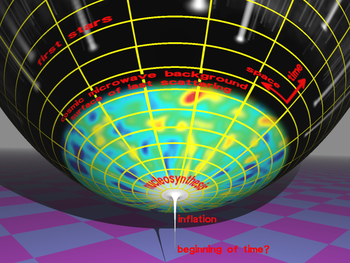The Big Bang is actually not a "theory" at all, but rather a scenario or model about the early moments of our universe, for which the evidence is overwhelming. It is a common misconception that the Big Bang was the origin of the universe. In reality, the Big Bang scenario is completely silent about how the universe came into existence in the first place. In fact, the closer we look to time "zero," the less certain we are about what actually happened, because our current description of physical laws do not apply to these occurrences of nature.
The Big Bang era of the universe presented as a manifold in two dimensions (1-space and time); the shape is right (approximately), but it's not to scale. (Photo credit: Wikipedia)
The Big Bang Theory hinges 100% on the assumption that scientist claim to have proven, that the universe is expanding.
Let's look at those assumptions, briefly here and determine how we came to the conclusion the universe is expanding!
Hubble found that the further away a galaxy was from us, the more severe the "redshifting". In other words, the redder the color of that galaxy. So redder color of an Ia Supernova, increase by 10%, means it moved 10% further away from us. That's because of a belief that as a galaxy moves farther away, the color of light changes and heads towards the red end of the spectrum.
 |
| English: Diagram of a dispersion prism (Photo credit: Wikipedia) |
So, The assumption of the change in color of a Supernova disregards the influence of bending of light by our own atmosphere, by gravitational waves or even inconsistent temperatures and the densities of the gasses, the curvature of spacetime. All blatantly ignored in order to make this theory seem somewhat credible.
So, by determining how fast the universe is "expanding" now, and then "running the movie of the universe" backward in time, we can mathematically determine the age of the universe. Using this formula, the result is that space started expanding 13.7 billion years ago. The problem with this picture, is that all calculations and estimates of the magnitude of the empty space energy so far, lead to absurdly large values.Unbelievably unscientific!
Secondly, if you look at a car driving off into the distance, surely, that by no means imply the world is getting bigger? Logic dictates, however, using the same criteria that we could be shrinking in relation to the universe!
It's a common misconception that the entire universe began from a single point. If the whole universe is infinitely large today, then it would have been infinitely large in the past, including during the Big Bang. How can an infinate universe, expand? Surely that is not possible?
It is, however, true that any finite chunk of the universe (such as the part of the universe we can observe today) can be predicted to have started from an extremely small unit.
The biggest contributor of the confusion is that scientists sometimes use the term "universe" when they're referring to just the part of it.we can see ("the observable universe"). And sometimes they use the term universe to refer to everything, including the part of the universe beyond what we can see.
It is further a huge misconception that the Big Bang was an "explosion" that took place somewhere in space. But the Big Bang was an expansion of space itself. Every part of space participated in it. For example, the part of space occupied by the Earth, the Sun, and our Milky Way galaxy was once, during the Big Bang, incredibly hot and dense. The same holds true of every other part of the universe we can see.
We assume that galaxies are rushing apart in just the way predicted by the Big Bang model. But there are other observations that scientist present in support of the Big Bang. Astronomers have detected, throughout the universe, two chemical elements that could only have been created during the Big Bang: hydrogen and helium. Furthermore, these elements are observed in just the proportions (roughly 75% hydrogen, 25% helium) theorized to have been produced during the Big Bang. This prediction is based on our Newtonian understanding of nuclear reactions—independent of Einstein's theory of gravity-Independent of Quantum weirdness and independent of the presence of so-called "Dark Matter". Yet, Quantum physics have lately been such a pain for scientists as it actually made us realize that our assumptions and laws do not apply to the quantum world.
The standard Hot Big Bang model is necessary to provide a framework in which to understand the collapse of matter to form galaxies and other large-scale structures observed in the Universe today. Without the theory, Scientists need to prove a whole lot of established LAWS all over again.





Comments (0)
Post a Comment